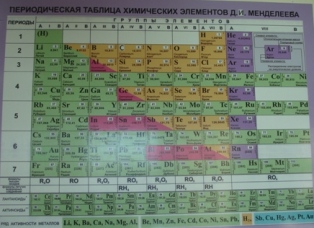The periodic table

 3.1 The periodic table (1 hour)
3.1 The periodic table (1 hour)
Pause for thought
 The wide variety of periodic tables available has been referred to already in the title page on Topics 3 &13. Periodic tables also provide a good example of International-Mindedness in Chemistry as they appear in many different languages and yet are instantly understandable by a chemist. One point that may be worth reflecting upon is that periodic tables are called something slightly different in Russian. Russian speakers refer to the periodic table as the Mendeleev table. We keep the names of Western scientists in many of our discoveries. For example, Faraday's Laws, Avogadro's constant and Le Chatelier's Principle. Why is it that we omit Mendeleev from the name of 'his' table when it is one of the most important concepts in the whole of Chemistry?
The wide variety of periodic tables available has been referred to already in the title page on Topics 3 &13. Periodic tables also provide a good example of International-Mindedness in Chemistry as they appear in many different languages and yet are instantly understandable by a chemist. One point that may be worth reflecting upon is that periodic tables are called something slightly different in Russian. Russian speakers refer to the periodic table as the Mendeleev table. We keep the names of Western scientists in many of our discoveries. For example, Faraday's Laws, Avogadro's constant and Le Chatelier's Principle. Why is it that we omit Mendeleev from the name of 'his' table when it is one of the most important concepts in the whole of Chemistry?
Nature of Science
Evidence for scientific theories is obtained by making and testing predictions.
The periodic table is an example of how subjects are organised by scientists based on subject and function. Early models of the periodic table enabled Mendeleev (and later Moseley) to predict the existence and properties of elements that had not yet been discovered.
Learning outcomesAfter studying this topic students should be able to: Understand:
Apply their knowledge to:
| Clarification notesStudents should know the terms alkali metals, halogens, noble gases, transition metals, lanthanoids and actinoids.
International-mindednessThe development of the periodic table involved scientists from different countries building upon the foundations of each other’s work and ideas and took many years. |
Teaching tipsThis topic naturally links with topic 2.2 Electron configuration. Once students understand the concept of groups and periods and realise that the periodic table is essentially set out in four blocks corresponding to whether the outermost electron is in an s, p, d or f sub-level then give them plenty of practice at deducing the electronic configuration from an element’s position in the periodic table. According to the statement in topic 2.2 students only need to be able to do this up to Z = 36, i.e. as far as krypton, 1s22s22p63s23p64s23d104p6. However they do also need to understand that the lanthanoids involve the filling of the 4f orbitals and the actinoids the filling of the 5f orbitals. The good thing about the periodic table is that by following it logically students do not need to remember which order the sub-levels get filled. I get them to work out the electron configuration of uranium taking it step by step. So that, for example, when the 5p sub-level has been filled and they have reached the configuration of Xe (Z = 54) the next element is caesium in group 1 (Z=55) so the next sub-level to be filled must be 6s. From Ce (Z=58) to Lu (Z=71) the 4f orbitals are filled followed by the 5d etc. Remember to include the anomalies of chromium and copper in your examples and also stress that the 4s electrons are lost before the 3d electrons when transition metal ions are formed. The 'Understandings' and 'Applications and skills' make no specific reference to the history of the periodic table. However it is one of the great achievements in science and you should encourage your students to read about it and discuss it as it is mentioned under the Nature of Science. | Study guide
Page 16 QuestionsFor ten 'quiz' multiple choice questions with the answers explained see MC test: Periodic table. For short-answer questions which can be set as an assignment for a test, homework or given for self study together with model answers see Periodic table questions. Vocabulary listperiodicity IM, TOK, Utilization etc.See separate page which covers all of Topics 3 and 13. |
Teaching slides
Teachers may wish to share these slides with students for learning or for reviewing key concepts.
Other resources
1. A rather simplistic short history of Mendeleev's discovery of the periodic table from the Science Channel videos.
2. A better video on the same topic from the BBC's Chemistry - a volatile history.
3. Martin Poliakoff shows you some of his collection of periodic tables and discusses why periodic tables are useful. Basically it is an introduction to the University of Nottingham series of videos about the periodic table.
4. An absolute classic by Tom Lehrer. If you want your students to learn the names of the elements (at least those that were known in 1967) just set them to music.
\
![]() The elements song - Tom Lehrer
The elements song - Tom Lehrer

 IB Docs (2) Team
IB Docs (2) Team 











